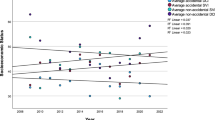Abstract
Data sources
PubMed, ISI, LILACS, Cochrane Library and Embase databases were searched.
Study selection
Epidemiological studies (cross-sectional, case-control, cohort clinical trials) addressing possible associations between socioeconomic indicators (eg mother's schooling, household income, number of children, type of school) and traumatic dental injury in the primary dentition were considered.
Data extraction and synthesis
Two reviewers independently selected studies. with study quality being assessed using the Newcastle-Ottawa Scale (NOS). Data were extracted for categorical variables considered risk factors for TDI and recorded based on the distribution and frequency of TDI among children exposed to risk factors vs the frequency among children not exposed to risk factors. Meta-analysis was undertaken.
Results
Sixteen studies (15 cross-sectional studies and one cohort study) were included. A wide range of socioeconomic indicators were investigated including; parents' schooling, parents' employment status, home ownership, having changed address in the previous year, income, family structure, number of residents in the home, number of children in the family, type of school and socioeconomic status. Children from families with household income less than two times average salary (US$ 592) (OR: 0.77; 95% CI: 0.66–0.90) or more than three times the average salary (US$ 888) (OR: 0.76; 95% CI: 0.65–0.89) had a significantly lower chance of having TDI in the primary dentition. TDI was not associated with socioeconomic status (high vs low – OR: 0.77; 95% CI: 0.43–1.36; high vs medium – OR: 1.03; 95% CI: 0.72–1.48; medium vs low – OR: 0.70; 95% CI: 0.42–1.19), house ownership (owned vs rented – OR: 1.28; 95% CI: 0.98–1.66), mother's schooling (OR: 0.89; 95% CI: 0.74–1.08), or father's schooling (OR: 1.01; 95% CI: 0.62–2.74).
Conclusions
The scientific evidence demonstrates that socioeconomic indicators are not associated with TDI in the primary dentition. The evidence of an association between a low income and TDI is weak. In general, studies had low risk of bias. Further prospective cohort studies are needed to confirm this association.
Similar content being viewed by others
Log in or create a free account to read this content
Gain free access to this article, as well as selected content from this journal and more on nature.com
or
References
Glendor U . Epidemiology of traumatic dental injuries--a 12 year review of the literature. Dent Traumatol 2008; 24: 603–611.
Bendo CB, Scarpelli AC, Vale MP, Araujo Zarzar PM . Correlation between socioeconomic indicators and traumatic dental injuries: a qualitative critical literature review. Dent Traumatol 2009; 25: 420–425.
Wikipedia. List of minimum wages by country; 2015.
Author information
Authors and Affiliations
Additional information
Address for correspondence: Patricia Corrêa-Faria, Av. Antonio Carlos, 6627, Faculdade de Odontologia, UFMG - Campus Universita rio 31270-901, Belo Horizonte, MG, Brazil. E-mail: patriciafaria.faria09@gmail.com
Corrêa-Faria P, Martins CC, Bönecker M, Paiva SM, Ramos-Jorge ML, Pordeus IA. Absence of an association between socioeconomic indicators and traumatic dental injury: a systematic review and meta-analysis. Dent Traumatol 2015; 31: 255–266.
Rights and permissions
About this article
Cite this article
Elkhadem, A., Wanees, S. Socioeconomic indicators and traumatic dental injury. Evid Based Dent 16, 120–121 (2015). https://doi.org/10.1038/sj.ebd.6401138
Published:
Issue date:
DOI: https://doi.org/10.1038/sj.ebd.6401138



